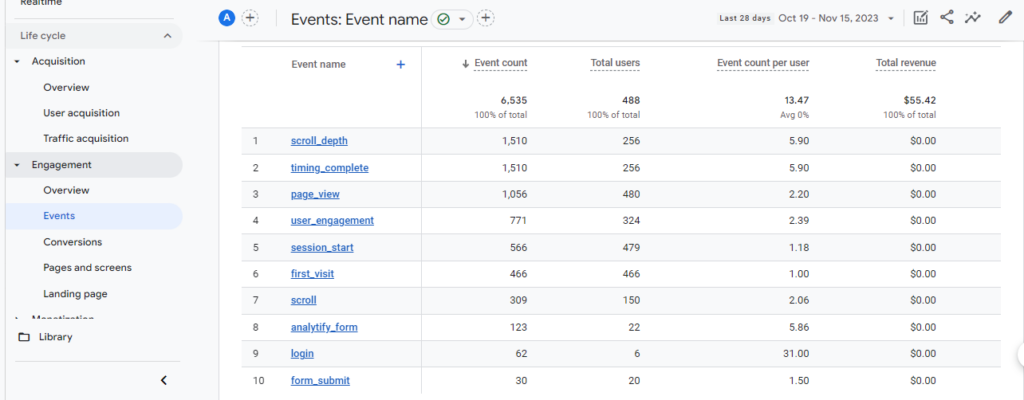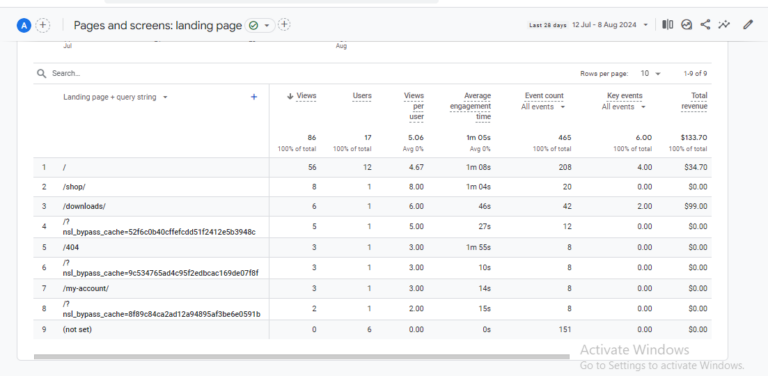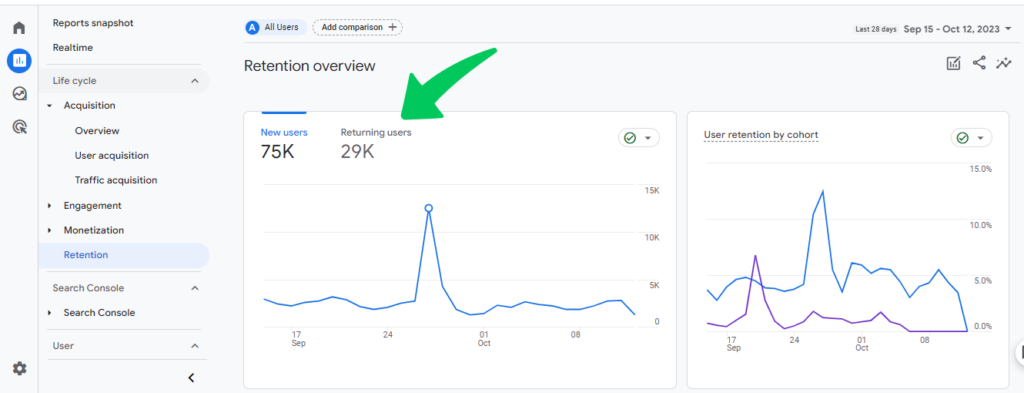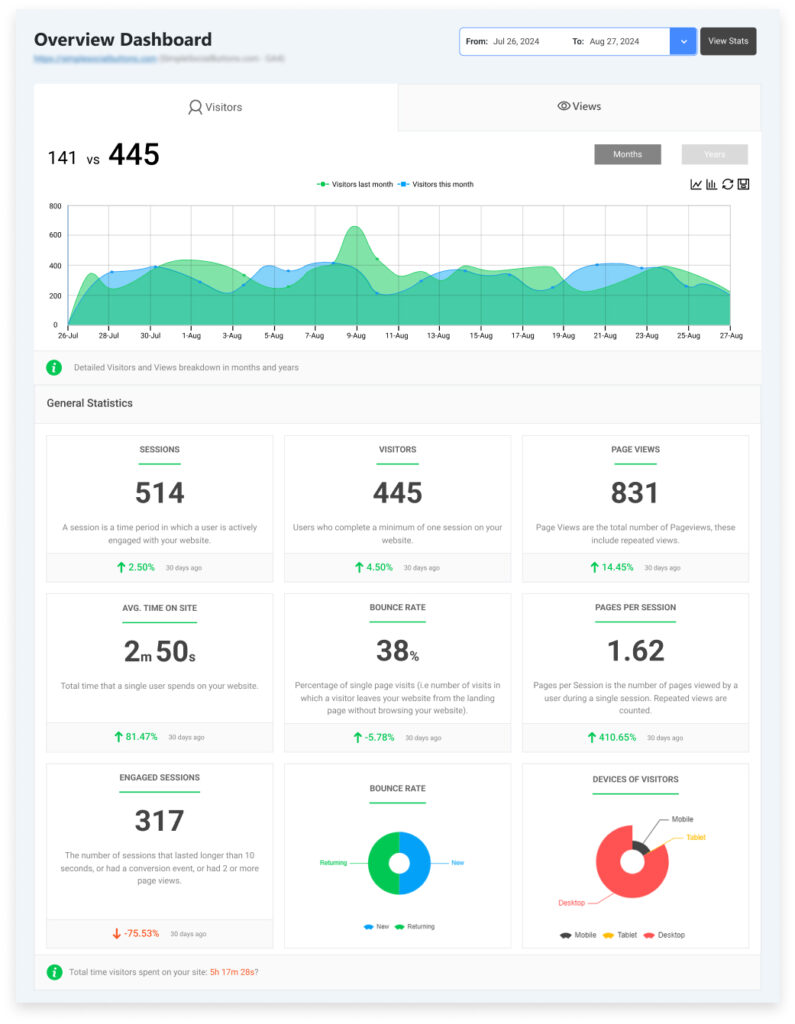
How Google Analytics Can Reveal Hidden Opportunities for Higher Rankings
Many brands deploy complex analytics tools to understand customer behavior on their websites and beyond. Such tools are often expensive and hard to use, but give the same level of insight as the good old Google Analytics. This free app has been around since 2005, getting better and better ever since.
Its latest version, Google Analytics 4 (GA4), can track hundreds of metrics, from scroll depth and page views to engagement rates. These insights enable businesses to fine-tune their marketing campaigns, create better content, and increase organic traffic.
Not only does GA4 offer in-depth insights, but it’s also easy to set up and customize. All you need to do is add your domain name to Google Analytics, install a tracking code on your site, and configure key events to start collecting data.
The knowledge you’ll gain from GA4 can be a game-changer, leading to higher search engine rankings and, ultimately, more sales. But first, you need to familiarize yourself with its features and identify the metrics that align with your business goals.
Table of Contents:
What Can You Do with Google Analytics?
More than half of all websites use Google Analytics to monitor traffic, visitor behavior, and engagement metrics. This free tool integrates seamlessly with Google Ads, Data Studio, Search Console, and third-party tools, offering insights into:
● Website traffic
● User demographics
● On-site behavior
● eCommerce performance and revenue trends
● SEO performance and organic search traffic
● Ad campaign performance
● User retention and lifetime value
And much more.
Common Enhanced Ecommerce mistakes can lead to inaccurate data, hindering your ability to identify opportunities for higher rankings. Understanding and avoiding these mistakes is vital for any e-commerce business using GA4.
Enterprises can use this data to understand why customers act the way they do and continuously optimize their marketing and advertising efforts.
For example, Google Analytics can tell you how people discover your website, how long they spend on each page, and what actions they take. If, say, they leave a particular page without visiting further pages, you may need to rework your content or look into issues like usability, accessibility, or page load speed.
With GA4, you can better understand what you do well and where you fall short. Basically, it helps you make sense of your data.
As far as SEO goes, GA4 provides the data you need to climb Google’s rankings. For instance, you can see what kind of content performs best and then replicate its success by covering related topics.
If you launched an outreach campaign, you can use the app to monitor traffic growth, backlinks, click-through rates, conversions, and more. Similarly, you can identify trends and patterns in visitor behavior after analyzing data from blog posts, landing pages, or product pages—and leverage these insights to decide on the next steps.
Google Analytics also has a paid version called Analytics 360, which offers more advanced features for websites receiving 10+ million page views per month. However, the free version is more than enough for the average business.
How to Use GA4 for SEO
The first step to using Google Analytics for SEO is to define your key performance metrics and how they fit into your overall marketing strategy.
For example, many businesses track the number of pages per session, but this metric alone doesn’t tell anything about user engagement or intent.
Other metrics, such as bounce rate, are useless for one-page websites or pages with infinite scroll. Plus, customers can “bounce” once they’ve found what they need (e.g., after reading a blog post that answered their question).
That being said, determine which SEO metrics are worth tracking with GA4. Next, think about how you’ll use these insights to improve your website’s search engine rankings. Here are some tips to help you out.
Let Go of Vanity Metrics
First, stop tracking metrics that don’t actually show how your business is doing. This step alone can free up your time to focus on what matters most.
Take page views, for example. High numbers don’t translate into increased engagement or conversions, as visitors may leave your site without taking any action.
The same goes for the number of unique visitors and other vanity metrics, such as:
● Time on page
● Total traffic
● Impressions
● Bounce rate
● Event count
For instance, bounce rate is the percentage of sessions that last 10 seconds or less and don’t trigger a conversion event or include more than one page view.
High bounce rates don’t really mean anything. A potential customer who lands on a blog page, reads it, and leaves is counted as a “bounce” in GA4, even though they engaged with your content.
If, say, a restaurant’s homepage has a 90% bounce rate, it might just mean users found the address or menu immediately—and that’s exactly what they were looking for.
On a similar note, you should focus less on total traffic and more on conversions. Sure, you want to see your traffic increase, but what’s the point in getting 5,000 hits per day if you’re not making any sales?
Track the Right SEO Metrics
Next, determine which metrics you’ll track and analyze with GA4. Consider your industry, target audience, business goals, and the issues you’re facing, such as low engagement or poor conversions.
Let’s see a few examples of SEO metrics to keep an eye on:
● Organic search traffic: The number of visits coming from unpaid search results;
● Active users: The number of people who engage with your website over a specific period;
● Returning users: The number of people who visit your site more than once;
● Total users: The number of visitors who take some sort of action, like clicking a button or making a purchase;
● Average engagement time: The average duration visitors engage with your website.
● Scroll depth: How far visitors scroll down a web page.
● Event count: The number of times users took action on your site (e.g., filled out a contact form or signed up for a product demo)
● Total revenue: The total amount of revenue generated from your website;
These metrics should never be analyzed in isolation. Instead, use GA4’s pre-made reports or generate custom reports to visualize multiple related metrics.
For example, organic traffic doesn’t tell you anything about visitor behavior. That’s why you should track it along with relevant metrics like user stickiness, views and event count, engaged sessions per active user, conversions, and more.
Go one step further and integrate GA4 with Google Search Console (GSC) and your CRM system for deeper insights.
By using GA4 and GSC together, you’ll gain a better picture of user behavior and your website’s performance in search results. The latter tool has a stronger focus on SEO, allowing you to monitor click-through rates (CTRs), search queries, top pages, backlinks, and other metrics you can’t track with GA4.
Fix What’s Broken
Look at your metrics to spot issues related to website performance, content quality, and other aspects that could affect your SEO efforts.
Let’s assume you’re getting a lot of organic traffic, but engagement is low. This could mean that:
● Visitors don’t find your content relevant
● Your site has technical issues (e.g., slow page load speed)
● There’s a mismatch between keywords and content
● You’re targeting the wrong audience
● Your CTAs are weak
What you should do next is conduct an SEO audit to find the root cause of disengagement. You could also use tools like HotJar or CrazyEgg to generate heatmaps showing how visitors interact with your site.
Monitor your metrics over longer periods and take action as soon as you notice anything unusual.
For example, a sudden drop in conversions could indicate a technical bug, such as a broken checkout button. These glitches may prevent users from completing their purchases and affect their experience with your brand.
A sharp decline in traffic, on the other hand, might signal an SEO problem like algorithm changes, deindexed pages, or lost backlinks. In some cases, it may result from link penalties, over-optimization, or outdated keywords.
Identify Your Top-Performing Pages
Check the Landing Pages report in GA4 to see which of your pages perform best. Focus on those generating the most traffic, engagement, conversions, and revenue.
Analyze these pages to see what works—and then apply it to other pages.
Let’s suppose you have a high-performing post about at-home workouts under 10 minutes. Create similar workout guides for different goals, such as fat loss, better endurance, or muscle gain.
This approach can help you reach a wider audience and increase organic traffic. It’s an opportunity to build internal links, target more keywords, and cover the topic in-depth.
Improve Internal Linking
Speaking of internal links, use GA4’s Explorations to see how visitors navigate your site. After that, interlink your pages strategically to drive traffic to new or underperforming content and boost conversions.
For example, GA4’s path exploration report can help you identify the pages opened by new users after landing on your homepage. It also outlines their actions before or after they complete an event while browsing your site.
Another option is to generate custom funnel reports so you can track the steps visitors take to complete specific tasks. These insights can uncover friction points in the buyer’s journey and help you find out where users drop off.
Leverage this data to optimize internal linking. If, say, most users leave after reading an article about fitness trends, add internal links to workout programs to keep them around for longer.
Fine-Tune Your Content Strategy
Track Engaged Sessions, scroll depth, and related metrics in GA4 to identify your best and worst-performing content.
For instance, Engaged Sessions are website visits that last longer than 10 seconds, include two or more page views, or trigger key events like subscriptions or purchases. This metric shows how well your content resonates with the target audience.
Let’s assume you have several pages with low Engaged Sessions. Chances are, their content is irrelevant, outdated, or poorly structured—and that’s something you can fix by:
● Covering the topic more thoroughly
● Breaking up the text with images and bullet points
● Adding engaging visuals
● Removing the fluff
● Including more recent data
● Rewriting certain sections
Make any changes you see fit, then monitor your engagement metrics for at least two or three weeks. If engagement rates remain low, conduct an SEO audit to gain further insights.
Analyze New vs. Returning Users
Check the number of new vs. returning users to gauge brand loyalty. Returning visitors are more likely to become customers and drive repeat business, leading to higher revenue. Plus, they may stay on your website longer and engage with your content, which can improve your SEO.
The new-to-returning-visitors ratio varies by industry, but generally, it should be around 30-50%. If it’s too low, you may need to rethink your content strategy, refine your follow-up approach, and drive more engagement.
Optimize Your Marketing Channels
Most websites get traffic from paid search results, organic searches, referrals, affiliates, social media, mobile push notifications, and other sources. With GA4, businesses can see where their traffic comes from and then focus on the top-performing channels.
Google Analytics has 18 predefined channel groups covering just about every traffic source one could think of. Use these insights to optimize your marketing spend and grow your reach.
For instance, you may realize that email marketing generates far more traffic than Instagram ads. The next logical step is to prioritize email communications and reduce your Instagram ad spend.
Meanwhile, try to figure out why your Instagram ads are not performing well and test new creatives, refine your targeting, or adjust your ad copy. Conduct A/B testing, track the results, and make adjustments as needed.
Pro Tip: Want to simplify all this data without digging through complicated GA4 reports?
Analytify makes Google Analytics beginner-friendly by turning complex numbers into clear, actionable insights inside your WordPress dashboard.
Join 50,000+ beginners & professionals who use Analytify to simplify their Google Analytics!
From tracking SEO metrics to monitoring conversions, Analytify helps you make smarter decisions without needing a data analyst.
Google Analytics for Higher Rankings (FAQs)
How can Google Analytics help improve SEO?
Google Analytics reveals how users interact with your website — including traffic sources, bounce rates, engagement, and top-performing pages. These insights help identify what content works, what needs improvement, and how to optimize for better rankings in search engines.
Which GA4 metrics are most useful for SEO?
Key SEO-related metrics in GA4 include:
Organic search traffic
Engaged sessions
Average engagement time
Scroll depth
Returning users
Conversions
These help you understand user intent, content performance, and areas for SEO improvement.
Can GA4 show which pages drive the most organic traffic?
Yes! GA4’s Landing Pages report and integration with Google Search Console let you see which pages attract the most users from search engines. You can also analyze engagement metrics to optimize those pages further.
How can I use GA4 to find content that needs improvement?
Look for pages with low engagement, short visit duration, or high exit rates. Combine this with scroll depth and conversion metrics to identify which content is underperforming and why. Then update, optimize, or repurpose it accordingly.
How does internal linking affect SEO, and how can GA4 help?
Strong internal linking helps distribute authority across pages and guides users to valuable content. GA4’s Path Exploration and User Flow reports show how visitors navigate your site, helping you optimize internal link placement to improve dwell time and SEO.
Final Thoughts: Get the Most Out of Google Analytics
Google Analytics involves a learning curve, and some features appeal to more advanced users. For starters, leverage this platform to track and monitor essential metrics and generate basic reports.
Better yet, use Analytify to turn GA4 data into actionable insights. With its intuitive dashboard, Analytify translates complex data for non-technical users, making it easier to understand the numbers you’re looking at.
Most importantly, act on your data. GA4 provides in-depth SEO insights, but these figures are useless if you don’t make tangible changes. Take small steps, such as improving your content or internal linking strategy, be consistent, and your rankings will improve over time.
We hope this blog helps you get the most out of Google Analytics to improve your ranking.
You may also like to read 11 Most Important Google Ranking Factors.








